April 19, 1979
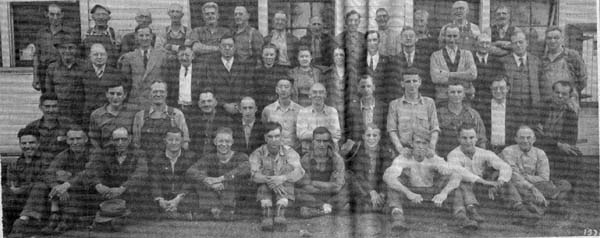
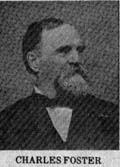
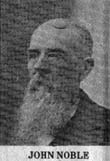
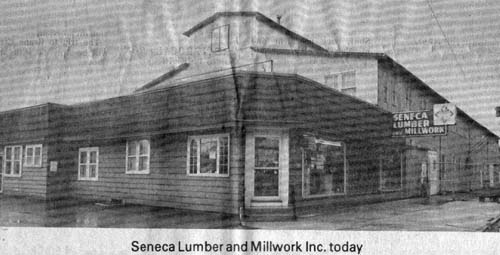
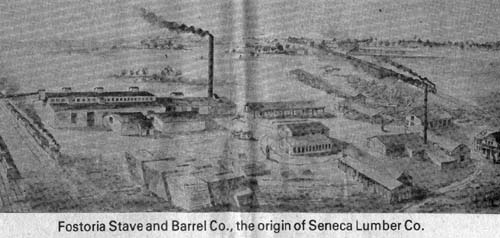
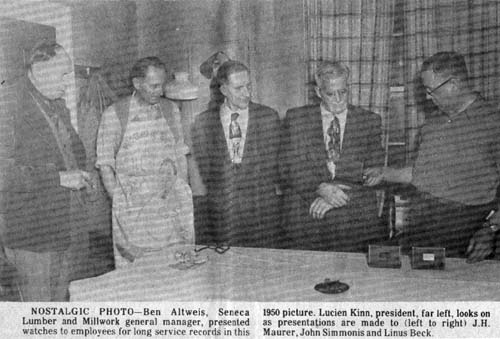
Picture #1 – Seneca Lumber Photo taken in 1936: Front row, left to right – Eldon Williams, Harold Dixon, (next unknown), “Shorty” Brubaker, Otto Pappenfus Jr., Dean Wilcox, Otto Omlor, Willerd Rader, James Bennet, William Lee, Earl Ebersole. Second row: Norman Phillips, Richard Atlweis, “Mandy” Myers, Roy Cook, James Lanne, Clyde Koch, J.B. Shaull, W.J. Knipple, A.J. Ewing, John Grundon, Jesse Early, “Shuffy” Sawyer. Third row: Martin Blaser, H.J. Blaser, Harvey Fry, Charles Manners, B.M. Altweis, Lucille Muir, Carolyn Kinnaman, Martha Ziegman, John Simmonis, (next unknown), J.H. Maurer, Willis Welty, G.P. Blaser, H. Markle. Fourth row: (first one unknown), John Hoffbauer, Jesse Henning, Homer Gallant, Linus Beck, Ray Logsdon, Louis McConnell, Harry Ernsberger, Al Zeigler, Albert Omlor Sr., Charles O’Dell, George Brown, Adam Bangert.
Picture #2 – Charles Foster
Picture #3 – John Noble
Picture #4 – Seneca Lumber and Millwork Inc. today
Picture #5 – Fostoria Stave and Barrel Co., the origin of Seneca Lumber Co.
Picture #6 – Nostalgic Photo – Ben Altweis, Seneca Lumber and Millwork general manager, presented watches to employees for long service records in this 1950 picture. Lucien Kinn, president, far left, look on as presentations are made to (left to right) J.H. Maurer, John Simmonis, and Linus Beck.
Fostoria’s oldest industry. The Seneca Lumber and Millwork Inc., is 106 years old this year. It was and is another one of those Fostoria business enterprises that was started by local men, with local money, and grew and prospered by hard work and business acumen.
Although the name has changed several times in those 106 years it has operated continuously, with some changes in the products made, but always related to wood.
Originally, the company was known as the Fostoria Stave and Barrel Co., organized by Charles Foster, former Ohio Governor; John Noble, a cooper by trade; and E.J. Cunningham, also experienced in the wood industry.
The company manufactured their wood barrels from the tree, the entire process being done at the local plant. It was known as “the best equipped cooperage plant in northern Ohio, being fitted with all the best steam appliances”, according to a descriptive booklet published about Fostoria’s industry at that time.
The accompanying photo shows an early photo of the plant, with the piles of logs awaiting processing into finished product. Unquestionably, the logs came from the local forests that surrounded Fostoria back then.
Barrels for flour, glass, carbon and other products were manufactured. A variety of custom cooperage work was also done, including close fitting staves, heading and hoops.
LARGE CUSTOMER LIST
All of the flour barrels for the Harter Milling Co. (predecessor to Mennel Milling Co.) and for other Fostoria companies were manufactured in the local plant, and shipments were made to many customers in the eastern part of the U.S.
The Fostoria Stave and Barrel Co. continued as a partnership until April 1893 when it was incorporated by Foster, Noble, Cunningham, in addition to William J. Boyer and Fred C. Myers. The first Board of Directors consisted of Foster, Noble, Cunningham, also William M. Day and William Jaeger. Jaeger continued to serve on the Board until his death in 1947.
In 1919, the original company bought and consolidated the F.W. Fraver Mill and changed the name to The Fostoria Building and Supply Co. The Fraver Mill was located on the northeast corner of McDougal and Town streets. They had been engaged in the manufacture of sash, door, blinds, and general millwork, and also sold building materials.
PRODUCT CHANGE
By this time (1919) the company’s business had gravitated from the earlier products or barrels and staves to the manufacture and sale of building materials.
In 1921 the company name was again changed to the Seneca Lumber and Millwork Co., at which time the Seneca Wire and Manufacturing Co. assumed control. Under the leadership of L.E. Kinn, president, the company grew and by 1938 the annual payroll had reached $100,000.00. The company was then operating a retail lumber yard, selling paint, lumber, building materials, and manufacturing woodwork for public buildings such as schools, colleges, hospitals, government buildings, hotels, office buildings and homes.
Other officers of the company during this period were: J.A. Wonderly, vice president; H.J. Blaser, secretary; B.M. Altweis, treasurer and general manager; G.P. Blaser, asst. secretary; directors: H.J. Baumstark and William Jaeger.
In the early days of the automobile business, when closed sedans became popular, the company was successful in getting contracts to manufacture various wood parts. When car sales increased substantially they lost that business to companies with special production lines for making such parts.
WORLD WAR II PRODUCTS
During the World War II years, Seneca Lumber was deeply involved in government work. They furnished millwork for government housing, and made a variety of items, such as footlockers, ammunition boxes, tote boxes, and all kinds of cabinets. Government contracts often consisted of dwelling units in quantities of 200 to 1000, which included frames, sash, interior molding, and various other wood parts.
At one time during their peak business years, Seneca had offices in New York, Pittsburgh, Cleveland and Detroit.
In 1954, the company was acquired by a Toledo company, and became known as Seneca Lumber and Millwork Co. Division Hixon-Peterson Lumber Co.
L.E. Kinn had died in 1952 and had been succeeded by H.J. Blaser as president and B.M. Altweis had become involved with the Home Window Co. With the sale of the company. Blaser devoted full time to presidency of Seneca Wire, and Altweis to Home Window. Wilbur Knipple who had been with the company for 31 years, and at that time was treasurer , was named manager by the new owners.
FOSTORIANS BUY-REORGANIZE
Ownership by Hixon-Peterson lasted only five years, and in 1959 eleven Fostorians purchased the plant and operation, incorporating it under the name of Seneca Lumber and Millwork, Inc. of the original incorporators three are still active: Wilbur J. Knipple, president and general manger; Melvin W. Schreiner, executive vice president and treasurer; Willerd D. Rader, vice president sales and secretary; Richard Altweis, one of the incorporators in 1959, and also plant superintendent, has since retired. Otto Omlor, a long time employee, was also one of the incorporators, retiring in 1971. Howard Heavener another one of the incorporators and of the original group. The present Board of Directors consists of the previously named officers, also Richard Altweis, W.E. Munsey and John Gutknecht, both of whom are among the eleven original incorporators and both on the Board.